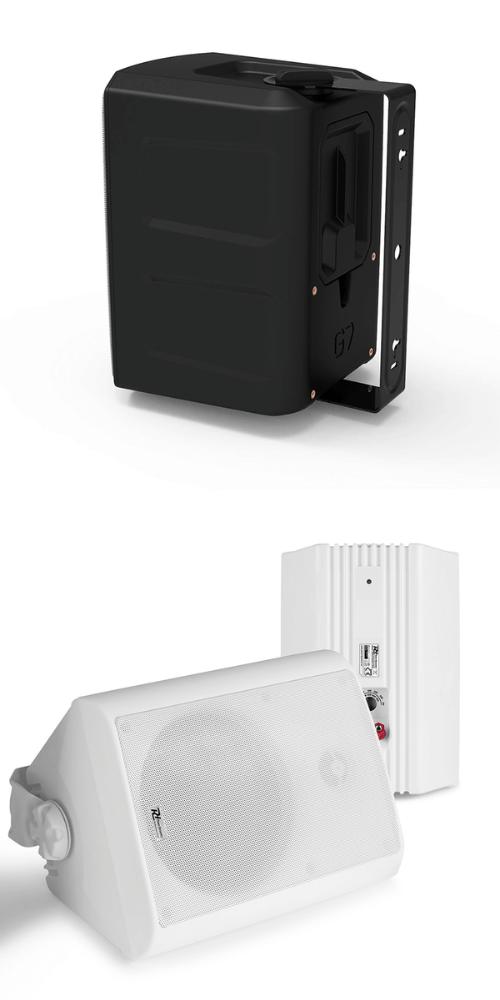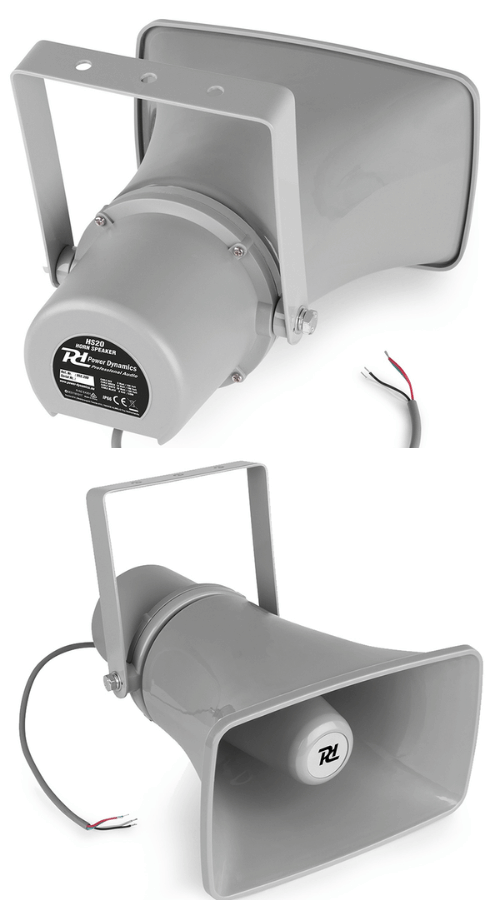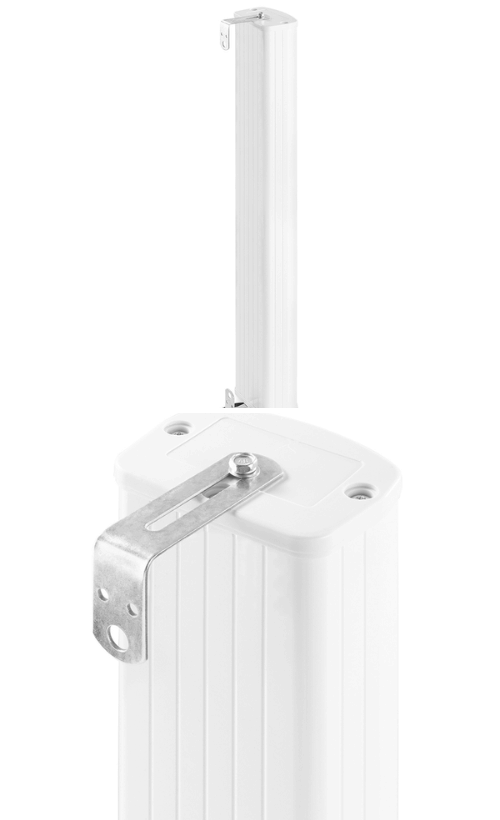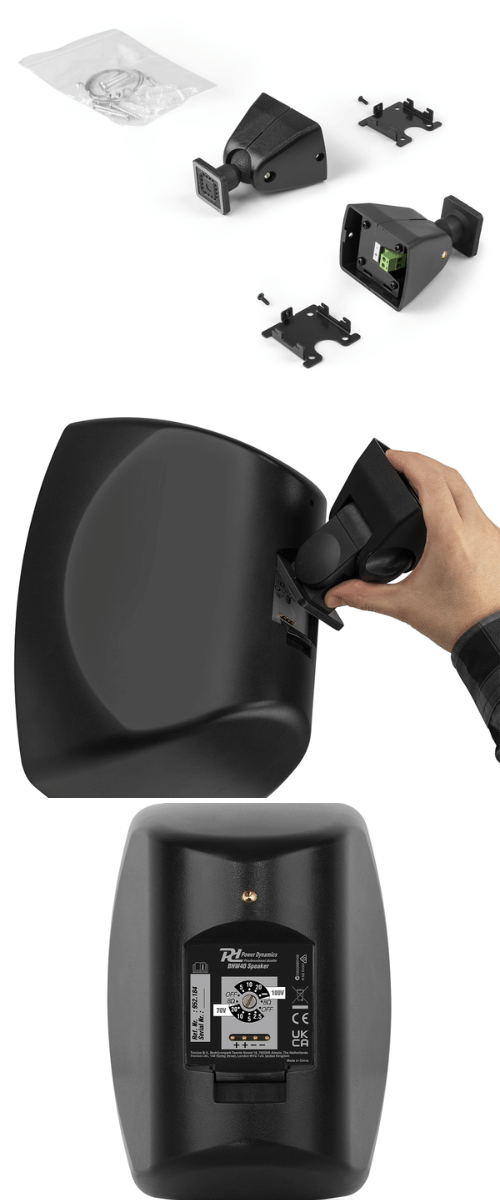When it comes to creating the perfect sound environment, whether in your home or a commercial space, the quality of your audio system is critical. Audio isn't just about filling a room with sound; it’s about delivering an immersive experience. This is where on-wall speakers come into play. On-wall speakers are becoming increasingly popular as people realise they can offer high-quality sound without compromising on space or style.
One of the key benefits of on-wall loudspeakers is how they combine excellent sound with a sleek, modern appearance. Unlike bulky floor-standing speakers, they free up floor space, providing a clean, uncluttered look that fits seamlessly into almost any environment. Whether you’re looking to improve your home cinema setup or want a discreet sound system for a restaurant or office, on-wall speakers offer a brilliant solution.
This blog post aims to guide you through the world of on-wall speakers, helping you understand their benefits, key features, and how to choose the best one for your needs. By the end of this post, you’ll be equipped with all the information you need to make an informed choice, ensuring that your next audio upgrade delivers in terms of both performance and aesthetic appeal.


Why Choose On-Wall Speakers?
On-wall speakers bring a unique blend of performance, versatility, and style that other types of speakers, like floor-standing or bookshelf models, may struggle to match. One of their standout advantages is their ability to deliver rich, room-filling sound while staying tucked away neatly on the wall. If you're short on floor space or simply prefer a cleaner, less obtrusive look, these speakers are a perfect match.
In residential settings, particularly in home theatres or living rooms, on-wall speakers can complement flat-screen TVs or be positioned around the room for an immersive surround-sound experience. Their ability to blend into a room’s design without dominating the space is a major selling point, especially for those who want to keep their living areas uncluttered.
On the commercial side, on-wall speakers are often the go-to choice for spaces like offices, restaurants, retail stores, and conference rooms. Their slim, modern design and convenient speaker wall bracket makes them ideal for delivering consistent sound across wide areas without being too visually prominent. Plus, they are versatile enough to work in spaces of all sizes. From pumping out background music in a café to enhancing voice clarity in a meeting room, on-wall speakers provide flexibility and performance that can easily match the demands of any setting.
Moreover, their wall-mounted nature offers superior sound dispersion compared to bookshelf speakers, which are often constrained by their placement on furniture. They can also save a significant amount of floor space compared to large floor-standing models, allowing for more freedom in furniture layout and room design. In short, if you’re looking for a speaker that delivers excellent sound without the bulk, on-wall loudspeakers are a smart and stylish solution.


Key Features to Consider When Choosing On-Wall Loudspeakers
When shopping for on-wall speakers, there are several key features you’ll want to take into account to ensure you’re getting the best performance for your space and needs.
Sound Quality
The most important aspect of any speaker is, of course, the sound quality. You'll want to pay close attention to the clarity, bass response, and overall audio output. A good on-wall speaker should be able to produce crisp highs, balanced mids, and deep bass, providing an engaging sound experience whether you're watching a film or playing music. Some on-wall speakers are designed for specific roles, such as centre-channel speakers in home theatre systems, where dialogue clarity is crucial, while others offer full-range sound suitable for both music and movies.
Design and Aesthetic
Since these speakers are visible on the wall, design and aesthetics play a major role in the decision-making process. The best on-wall speakers should seamlessly integrate with your existing décor, whether that’s blending into a minimalist setup or standing out as a stylish feature. Many models come in neutral colours like black, white, or grey, but some brands offer customisable finishes to match your interior design. Size is another important factor—while compact models are less noticeable, larger speakers can add a bold visual statement, provided they don’t overwhelm the room.
Installation Flexibility
On-wall speakers are relatively easy to install, but some models are more flexible than others when it comes to mounting and positioning. The best options offer adjustable speaker wall brackets that allow you to angle the speaker for optimal sound direction. This can be especially useful in irregularly shaped rooms or in setups where you want to direct the sound toward a specific seating area. Additionally, look for speakers that offer a clean installation with minimal visible cabling—some even come with in-wall wiring options to maintain that sleek, tidy appearance.
Durability
If you’re planning to use on-wall speakers in outdoor areas or spaces with high moisture levels, such as a bathroom or a patio, it’s important to consider the durability and weather resistance of the speakers. Many manufacturers offer models that are specifically designed to withstand the elements, featuring waterproof housings and rust-resistant materials. This ensures that your investment will hold up over time, even in more challenging environments.
Power Handling
Lastly, consider the power handling capacity of your speakers and how well they’ll pair with your existing or planned amplifier. Power handling refers to the amount of power (measured in watts) that the speaker can handle from the amplifier without distortion. Ideally, your amplifier's power output should match or be slightly lower than the speaker's maximum power rating for optimal performance. Going too high can risk damage, while too low might not deliver the full potential of the speaker's sound. By ensuring the power compatibility between your amplifier and on-wall speakers, you’ll achieve clearer sound and avoid performance issues like distortion or audio dropouts.
By considering these key features, you can narrow down your options and find an on-wall speaker that delivers the perfect balance of sound quality, style, and practicality for your specific needs.
Types of On-Wall Speakers
There’s a wide range of on-wall speakers available, each designed for different environments and listening needs. Whether you're setting up a home cinema, designing a sound system for a restaurant, or installing a public address system in a warehouse, the type of on-wall speaker you choose will have a significant impact on the overall sound quality and performance. In this section, we’ll explore the main categories of on-wall speakers, their uses, and key features.
Wall Mount Speakers
Wall mount speakers are compact, versatile units that offer balanced sound without taking up much space. Typically designed for indoor use, many models are also suitable for outdoor environments, making them a flexible option for both residential and commercial applications. These speakers are particularly popular in spaces like retail stores, offices, and restaurants, where their low-profile design helps them blend into the environment while still providing excellent sound coverage.
Power Dynamics 100V Line Wall Speakers: These speakers are built for commercial environments that require multi-room audio distribution. Their 100V line system makes them ideal for larger spaces where you need uniform sound coverage across multiple rooms. The Power Dynamics wall speakers are known for their clear sound, making them a top choice for background music or public announcements in places like shopping malls, restaurants, or even large office buildings.
E-Audio Wall Speakers: For those seeking a more affordable option without sacrificing ease of installation or sound quality, E-Audio’s wall speakers are an excellent choice. They’re compact and straightforward to mount, making them perfect for small retail spaces or offices where budget constraints might be a concern but sound clarity is still important.
Use Cases:
Wall mount speakers are a popular choice for various commercial settings such as retail stores, restaurants, and office spaces. In these environments, background music or announcements are often needed to cover a broad area, and wall-mount speakers provide the necessary sound clarity and coverage without overwhelming the space.
Key Features:
Wall mount speakers typically offer:
- Wide sound coverage, ensuring consistent audio throughout the space.
- Clear, balanced audio that’s suitable for both speech and background music.
- Easy installation with adjustable mounting brackets, allowing you to direct sound where it’s needed most.




Horn Speakers
Horn speakers are designed for high-output performance, projecting sound over long distances with excellent clarity. They’re often found in outdoor environments or large public spaces where loud and clear announcements are critical. Due to their rugged build and ability to handle harsh weather conditions, they’re perfect for settings where durability and long-range sound projection are essential.
PD 100V Line IP Rated Horn Speakers: These horn speakers are designed for outdoor use, featuring weatherproofing that ensures they can withstand rain, wind, and even dust. This makes them a great choice for large industrial spaces, construction sites, or any area where background music or important announcements need to be heard over long distances.
Use Cases:
Horn speakers are commonly used in outdoor environments such as public parks, warehouses, and at large public events. They’re ideal for spaces where sound needs to travel over long distances without losing clarity, making them a preferred choice for public address systems, emergency announcements, and outdoor event commentary.Key Features:
- Long-range sound projection, making them suitable for wide, open areas.
- High durability and weather resistance, ensuring they can handle outdoor conditions without sacrificing performance.
- High efficiency in delivering clear audio at high volumes, perfect for public announcements or emergency signals.
Column Speakers
areas. Their vertical arrangement of multiple speaker drivers helps to focus sound, reducing echo and delivering clearer audio in spaces with challenging acoustics. These speakers are particularly effective in environments like churches, conference rooms, and auditoriums, where sound needs to reach a wide audience without losing clarity or becoming distorted.
Audica Column Speaker: Known for its superb speech intelligibility, the Audica column speaker is perfect for environments where clear communication is a priority. Whether installed in a church or a large conference hall, these speakers deliver balanced sound that ensures everyone in the room can hear clearly, even in spaces with high ceilings or challenging acoustics.
PD Metal Column Speakers: Designed for larger commercial spaces, the PD column speakers are a powerful option for delivering clear, undistorted sound in environments like schools, auditoriums, or large retail outlets. Their durable metal casing also makes them an excellent choice for areas where durability is essential.
Use Cases:
Column speakers are frequently used in venues with large, open spaces where echoes and sound distortion can be an issue. Churches, conference rooms, and auditoriums often turn to column speakers for their ability to direct sound clearly to all corners of the room, ensuring that speech and music are both heard clearly.
Key Features:
- Ability to reduce sound distortion, even in large or echo-prone spaces.
- Focused sound dispersion, ensuring audio reaches every part of the room evenly.
- Slim, unobtrusive design, which blends well into spaces where aesthetics are important.


Comparing the Different Types of On-Wall Speakers
When it comes to on-wall speakers, choosing the right type depends on your specific needs. Each type offers unique features suited for different environments and applications. Here’s a closer look at how wall mount, horn, and column speakers compare in key areas like sound projection, coverage, and design.
Wall Mount vs. Horn Speakers
The main difference between wall mount and horn speakers comes down to sound projection and coverage.
Wall Mount Speakers: These are designed for relatively close-range applications where balanced sound is required throughout a room or space. They offer a more even and immersive sound distribution, making them perfect for indoor environments like restaurants, offices, and small commercial spaces. The sound coverage is broad but typically confined to the immediate area around the speaker, ideal for background music or enhancing ambience without being intrusive.
Horn Speakers: In contrast, horn speakers excel at long-range sound projection. They focus sound in a specific direction, making them perfect for larger, open spaces or outdoor environments. Horn speakers are designed to project sound over long distances with high clarity, which is why they’re often used in public address systems or large venues. The audio from horn speakers is more directional, meaning it travels further but doesn’t provide the same broad, even coverage that wall mount speakers do.
Best-use environments
Wall Mount Speakers: Indoor spaces like offices, retail stores, and smaller commercial areas.
Horn Speakers: Outdoor areas, warehouses, and environments where long-range sound projection is crucial, like car parks or stadiums.
Horn vs. Column Speakers
Both horn and column speakers are designed for large spaces, but their sound dispersion patterns and overall performance differ significantly.
Horn Speakers: These speakers deliver focused, directional sound, projecting audio over long distances in a straight line. They’re great for loud, clear announcements in outdoor settings or large open areas where speech intelligibility over long distances is key. However, because of their focused sound, they’re not ideal for environments with significant echo or where wide coverage is needed.
Column Speakers: Column speakers, on the other hand, offer a wider and more even sound dispersion pattern. The vertical arrangement of multiple speaker drivers helps to direct sound across larger areas while minimising echo and reverberation. This makes column speakers an excellent choice for spaces with tricky acoustics, such as churches, conference rooms, or auditoriums, where clear speech across a broad area is essential.
Best-use environments
Horn Speakers: Large, open outdoor spaces requiring focused, long-distance sound projection.
Column Speakers: Indoor venues with large audiences and echo-prone spaces like churches, lecture halls, or auditoriums.
Wall Mount vs. Column Speakers
Wall mount and column speakers are often used in commercial settings but differ in how they deliver sound and integrate into a space.
Wall Mount Speakers: Wall mount speakers are compact and blend seamlessly into the décor of most spaces. They offer balanced sound for close- to mid-range coverage, making them perfect for areas like retail stores, offices, or restaurants. Their installation flexibility allows for easy placement in a variety of settings, and they work well in environments where aesthetics matter.
Column Speakers: Column speakers are taller and more visible than wall mount speakers, but their design is still slim and unobtrusive. Where they stand out is in their ability to focus sound over large areas, delivering clear audio to people seated far from the speaker. They’re ideal for environments like conference rooms or places of worship, where speech clarity and wide coverage are key, and sound distortion needs to be minimised.
Best-use environments:
Wall Mount Speakers: Spaces requiring aesthetic integration, such as retail environments or small offices.
Column Speakers: Large indoor spaces where speech intelligibility and wide sound dispersion are critical, such as churches, auditoriums, or conference rooms.


How to Choose the Best On-Wall Speaker for Your Needs
Selecting the right on-wall speaker depends on the space you’re working with and the specific audio requirements. Below, we’ll break down some of the best options based on whether you’re looking for a commercial or residential speaker setup.
For Commercial Use
Wall Mount Speakers for Broad Coverage and Speech Intelligibility: If you’re setting up sound in a space like a restaurant, retail store, or office, wall mount speakers are a top choice. They provide excellent sound quality for background music and public announcements while maintaining a discreet appearance. Their broad coverage and easy installation make them perfect for small to mid-sized commercial environments where speech intelligibility is important but long-distance projection isn’t required.
Horn Speakers for Long-Distance Sound Projection: For outdoor or large open spaces, horn speakers are the go-to option. Whether you’re equipping a warehouse, large outdoor area, or a sports venue, horn speakers deliver sound over long distances with high clarity, making sure that announcements or emergency signals reach everyone. Their weather-resistant design also makes them ideal for environments exposed to the elements.
Column Speakers for Large Venues and Clear Speech: If your commercial space is a venue where clear, undistorted speech is crucial—such as in conference rooms, churches, or lecture halls—column speakers are your best bet. Their focused sound dispersion helps prevent echoes and ensures that everyone, even in the back row, can hear clearly. They’re especially effective in large venues where balanced audio and speech clarity are essential.
For Residential Use
Wall Mount Speakers for Home Theatres, Kitchens, and Patios: For home installations, wall mount speakers provide the perfect balance of form and function. In home theatres, they can be placed around the room to create an immersive surround-sound experience without taking up valuable floor space. Wall mount speakers are also great for adding background music to kitchens, living rooms, or outdoor areas like patios and gardens. Many models are weather-resistant, making them suitable for outdoor use, where they can enhance your backyard gatherings without cluttering your space with bulky audio equipment.
By considering your specific needs—whether it’s creating an engaging atmosphere in a restaurant or ensuring every word is heard clearly in a large venue—you can confidently choose the right type of on-wall speaker for the job. Each speaker type offers unique strengths, allowing you to tailor your audio setup to fit the space and purpose perfectly.




Installation Tips for On-Wall Speakers
Proper installation is key to getting the most out of your on-wall speakers, ensuring both optimal sound quality and a clean, professional appearance. Below are some basic tips and best practices to guide you through the process:
Basic Installation Tips
Before you start, make sure you have all the necessary tools, such as a level, drill, and screws appropriate for the type of wall you’ll be mounting the speakers on. Always refer to the manufacturer’s instructions to ensure a secure and safe installation.
Speaker Placement: For the best sound quality, placement is crucial. In general, speakers should be mounted at ear level when seated, particularly for home theatres or music listening areas. For background music in commercial spaces, mounting speakers slightly above ear level ensures broader sound coverage without overwhelming those nearby.
Distance from Walls and Ceilings: Avoid placing speakers too close to corners, walls, or ceilings, as this can cause sound to reflect and distort. A general rule is to leave at least 15-20 cm (6-8 inches) of space between the speaker and nearby surfaces to allow for clear sound dispersion.
Optimising Placement for Sound Quality
Speaker placement directly impacts how sound travels throughout the room, and different speaker types have different placement requirements:
Wall Mount Speakers: Place wall mount speakers evenly across the room for consistent sound coverage. In a home theatre, wall mount speakers should be placed around the seating area, with the centre speaker just below or above the TV and the side speakers placed at ear level. For commercial spaces like restaurants or stores, consider distributing them evenly around the perimeter for balanced background music.
Horn Speakers: Horn speakers need to be aimed directly at the area where sound needs to be projected. Since these speakers work best over long distances, make sure they are placed high enough (usually 3-4 metres) to avoid obstructions. In outdoor settings, ensure they are mounted securely to withstand weather conditions, using brackets that allow for angle adjustments.
Column Speakers: These speakers should be mounted vertically to take advantage of their narrow sound dispersion, and they’re typically placed on walls that face the audience or congregation in large venues. Because they are designed to reduce echo, you can place them in areas where sound clarity is important, such as along the sides of a room.
Wired vs. Wireless Setup
On-wall speakers come in various configurations, each with different installation requirements:
Wired Speakers: These are often 100V line systems used in larger commercial installations, such as retail stores and offices. Wired speakers require planning for cable routing, so make sure to run cables through the walls or ceiling for a clean look. Consider using in-wall speaker cables for a more polished finish.
Bluetooth or Wireless Speakers: These are more common in residential settings, where a quick and easy setup is desired. Wireless speakers eliminate the need for visible cables, but you’ll need to ensure they’re placed within range of the source (like a TV or smartphone) for reliable signal transmission.
Additional Considerations
Weatherproofing: If you’re installing speakers outdoors or in humid environments (like patios or bathrooms), make sure they are weather-resistant. Look for IP-rated speakers, which are designed to withstand exposure to moisture and dust.
Amplifier Compatibility: For larger setups, especially those using 100V line systems, ensure your amplifier is correctly matched to your speaker’s power-handling capacity to avoid sound distortion or damage to your equipment.
Conclusion
Choosing the best on-wall speaker for your space is all about understanding your specific needs. Whether you're looking for broad sound coverage in a retail space, long-distance sound projection in an outdoor venue, or immersive audio for a home theatre, there’s a speaker designed for your exact application. Each type of on-wall speaker—whether it’s a compact wall mount model, a powerful horn speaker, or a versatile column speaker—has its own strengths that cater to different environments and sound requirements.
At Audio Installations, you’ll find a wide range of high-quality, reliable on-wall speakers to suit any space, from small residential setups to large commercial installations. As you browse your options, consider important factors such as budget, sound quality, installation requirements, and the specific needs of your environment to make the best choice for your setup.
Ready to enhance your space with the perfect on-wall speaker? Explore our range of products at Audio Installations and take the first step toward a sound experience tailored to your needs.




